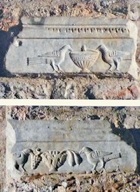


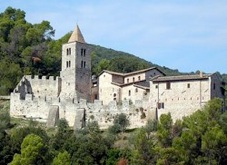
The earliest surviving documentary reference to the Abbazzia di San Cassiano dates to 1091, when Bishop Rodolfo of Narni conceded it to the Abbazia di Farfa (see below). However, two now-lost inscriptions from San Cassiano that are illustrated in a poster in the Museo della Città e del Territorio suggest that there was a monastery here from a very early date:
-
✴An inscription on a small Roman sarcophagus read:
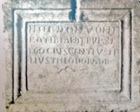
-
HOC DONU OFFE-
-
RO TIBI BEATE URSE
-
ECO CRESCENTIUS FI-
-
LIUS THEODORADE
-
I, Crescentius, son of Theodora, give this gift to you, Blessed Orso.
-
✴A second inscription read:
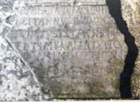
-
A(nno) D(omini) M(illesimo) C(entesimo) M(ense)
-
AP(rilis) D(ie) V (h)IC
-
RECONDIT (um) (est) BEATI URSI CORPUS
-
This records the rediscovery of the remains of the Blessed Orso on 5th April, 1100.
These inscriptions were of considerable historical interest:
-
✴Crescentius I, who appears in the first inscription, was the most powerful man in Rome during most of the decade before his death in 984. He was the son of John Crescentius and Theodora, the younger sister of the infamous Marozia and thus a member of the powerful Roman Theophylact family. After his mother’s death, his father had become Bishop John of Narni (940-60). His brother succeeded their father as bishop of Narni, before the Emperor Otto I appointed him as Pope John XIII (965-72). (It is interesting that he referred only to his mother in the Narni inscription: his epitaph in the Roman monastery of San Bonifacio (now Sant’ Alessio), Rome, where he lived as a monk in the last few months of his life, refers to both his father and his mother).
-
✴Blessed Orso was presumably a venerated monk at San Cassiano in the 10th century; his remains were presumably in the Roman sarcophagus when they were rediscovered in 1100.
Circumstantial evidence points to an even earlier foundation of an abbey on this site:
-
✴St Cassian, the titular of the church, was probably St Cassian of Autun (died ca. 350), who was reputed to have been Bishop of Orte before moving to France.
-
✴The Byzantine general Belisarius built a monastery at Orte dedicated as San Giovenale in honour of the patron of Narni in ca. 537
It is possible that Belisarius in fact built "twinned" fortified monasteries on Via Flaminia to protect part of the Byzantine corridor through Lombard territory that linked Ravenna and Rome.
Access to San Cassiano is via a narrow footpath that leads steeply upwards through woodland. However, it was probably more easily reached before the nearby Ponte di Augusto collapsed in ca. 1050.
Later History
As noted above, Bishop Rodolfo of Narni conceded San Cassiano to the Abbazia di Farfain 1091. Farfa enjoyed Imperial patronage, and took the side of the Emperors Henry IV and Henry V in the Investiture crisis. Its abbot, Berardus III supported the campaign of Henry V against Pope Paschal II, and a monk from the abbey (perhaps Gregory of Catino) wrote the influential Orthodoxa defensio imperialis (Orthodox Defence of the Empire) in 1111. Narni rebelled against the papacy in 1112 - this was probably as a result of the influence of Farfa in the city.
The church and monastery were enclosed in a wall with battlements in the 15th century. The abbey passed in commendam to Cardinal Berardo Eroli in 1453: the presence of the Eroli arms on one of the bifore windows of the campanile suggests that it might date to this period.
Ownership of the abbey was contested between the bishops of Narni and a series of would-be commendatory abbots from the 16th century. The monks moved away and the abbey fell into disrepair, a situation that was not reversed when it passed into private ownership in 1849. The ruined abbey was appropriated by the Italian Government in 1960 and restored in the period 1963-70. It is now, sadly, closed.
Architecture
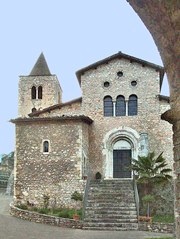
A flight of steps leads up to the façade of the church, which has a fine portal: the three-light window and three small oval windows above have been reconstructed.
The church that was built (or rebuilt) in the 10th century was on a Greek Cross plan. In 1334, its lateral extremities were demolished and it was converted to a Latin Cross with a nave and two aisles.
The interior was stripped of its Baroque decoration during the restoration of 1963-70. The foundations of the apsed right arm of the Greek Cross that had been demolished in 1334 were found during this restoration.
